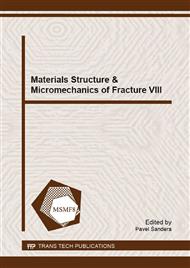p.558
p.562
p.566
p.570
p.574
p.579
p.583
p.587
p.591
Microstructure Analysis and Mechanical Properties of Low Alloy High Strength Quenched and Partitioned Steel
Abstract:
Gleeble study of the quenching and partitioning (Q&P) process has been performed on Domex 960 steel (Fe, 0.08 %C, 1.79 %Mn, 0.23 %Si, 0.184 %Ti, and 0.038 %Al). The effect of different Q&P conditions on microstructure and mechanical properties were investigated. The aim of the process is to produce a fine grained microstructure for better ductility and controlled amounts of different micro-constituents to increase the strength and toughness simultaneously. Three different quenching temperatures, three partitioning temperatures and three partitioning times have been selected to process the 27 specimens by Gleeble® 1500. The specimens were characterized by means of OM, SEM, XRD, hardness and impact tests. It was found that, fine lath martensite with retained austenite is achievable without high amount of Si or Al in the composition although lack of these elements may cause the formation of carbides and decrease the available amount of carbon for partitioning into the austenite. The hardness increases as the quenching temperature is decreased, however, at highest partitioning temperature (640◦C) the hardness increases sharply due to extensive precipitate formation.
Info:
Periodical:
Pages:
574-578
Citation:
Online since:
December 2016
Keywords:
Permissions:
Share:
Citation:


